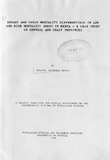| dc.contributor.author | Muluye, Shiferaw D | |
| dc.date.accessioned | 2013-05-08T16:52:17Z | |
| dc.date.available | 2013-05-08T16:52:17Z | |
| dc.date.issued | 1995 | |
| dc.identifier.uri | http://erepository.uonbi.ac.ke:8080/xmlui/handle/123456789/20460 | |
| dc.description.abstract | Studies of infant and child mortality by several researchers
in the past have revealed the nature and extent thereby
contributing important findings for sound policy making. Although
mortality in general and infant and child mortality in particular,
have declined in Kenya and other developing countries, the effects
of HIV/AIDS and structural adjustment programme (SAP) are creating
a new dimension in demographic trends in Kenya. For instance, In
1993 world data sheet, IMR for Kenya was 63 per 1000 live births.
In 1994 and 1995 World Data Sheets, the parameter was projected to
be higher 66 and 69 per 1000 live births respectively. Thus
further study lS required
child mortality.
This study attempted
in the quest to understand infant and
to examine infant and child mortality
differentials between low and high mortality zones taking Central
Province and Coast Province as case representatives. Kenya
Demographic and Heal th Survey (KDHS, 1993) was the Source of
Secondary data and Trussell's indirect technique was employed in
the data analysis. The variables selected for the study were
maternal education, Source of drinking water, Breastfeeding and
Tetanus Injection before birth. Estimates for IMR (1q0)' CMR(1q4)'
q2' q3 and q5 were computed and Life table was constructed for each
variable based on Coale and Demeny West Model probabili ty of
survival.
The findings were that maternal education is inversely
related to infant and child mortality in Central Province. In
Coast Provih~e women with secondary education
conformi ty with the preset hypothesis. Regarding
did not show
Breastfeeding,
women currently breast feeding experience lower IMR and CMR and
higher life expectancy than those who do not currently breastfeed.
An astounding result was found regarding the association of
source of drinking water and infant and child mortality that
mothers who use tap water" experience lower child survival than
those who use other types of drinking water such as river/well/etc.
Finally, mothers who received tetanus injection before birth
experience better chance of child survival than th6se who did not
receive.
Recommendations for policy making and for further study are
also suggested. | |
| dc.description.sponsorship | University of Nairobi | en |
| dc.language.iso | en | en |
| dc.subject | Infant & child mortality | en |
| dc.subject | Low & high mortality zones | en |
| dc.subject | Kenya | en |
| dc.title | Infant and Child Mortality Differentials in Low and High Mortality Zones in Kenya | en |
| dc.title.alternative | A case study of central and coast provinces | en |
| dc.type | Thesis | en |
| local.publisher | Department of Population Studies & Research Institute, University of Nairobi | en |

